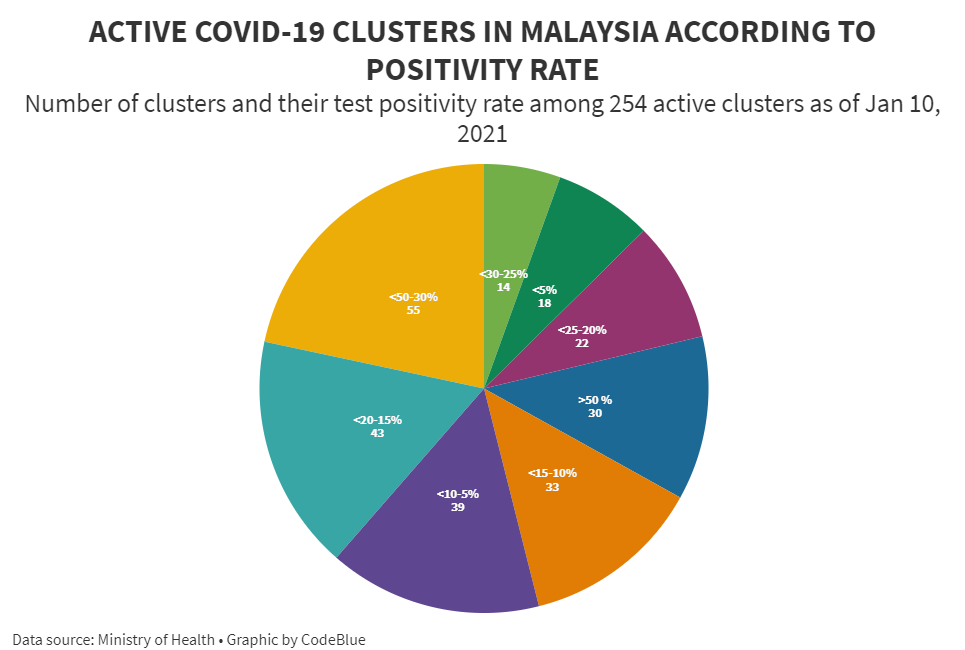KUALA LUMPUR, Jan 18 — More than nine out of 10 active Covid-19 clusters in Malaysia as of January 10 had a test positivity rate of above five per cent.
With 254 active Covid-19 clusters in Malaysia as of that date, 236 active clusters, or 92.9 per cent, had a positivity rate above five per cent, exceeding the World Health Organization’s (WHO) recommendation, indicating that Malaysia is not doing enough testing to catch mild or asymptomatic coronavirus cases.
This is a drastic increase in the number of clusters with a positivity rate above five per cent as compared to December, 2020. On December 2, CodeBlue reported that the total number of active clusters with a positivity rate above five per cent was only 150 clusters, 86 clusters fewer as of January 10.
Meanwhile, a total of 30 active clusters have a positivity rate above 50 per cent. This means, one out of two people screened from these clusters will test positive for Covid-19. Besides that, a total of 55 clusters have a positivity rate between 30 and 55 per cent.
Among the 30 active clusters with a positivity rate above 50 per cent, 73.3 per cent (22 clusters) were reported in the Klang Valley, 18.2 per cent (four clusters) were reported in Sabah, two clusters in Johor,one cluster in Sarawak, and one in Negeri Sembilan.
Overall, only 7.09 per cent of active Covid-19 clusters have a positivity rate below five per cent, which means only 18 clusters have a positivity rate less than five per cent. A low positivity rate means that community transmission of Covid-19 is low.
The largest cluster reported to date is the Teratai cluster that was detected among foreign workers from Top Glove’s factory in Klang, in which among the 9,540 individuals screened as of January 10, a total of 6,469 people tested positive, translating to a positivity rate of 67.81 per cent.
Despite the high positivity rate from this cluster, the total number of screening done was only 9,540. Top Glove reportedly employs 13,000 workers in 28 factories in Klang.
Meanwhile, the Penjara Jalan Harapan cluster that is also located in Selangor has a high positivity rate of 46.6 per cent as among the 6,826 individuals screened, 3,181 of them tested positive.
As of January 10, the highest number of screenings was done for individuals from the Beringin cluster, which was first detected among factory workers in two factories in Penang. A total of 18,301 tests were conducted and 1,694 cases were detected from this cluster, with a positivity rate of 9.26 per cent.
According to Johns Hopkins Bloomberg School of Public Health, a high positivity rate suggests a high transmission of Covid-19 within the community. A high positivity rate means that the number of tests being conducted is low and not enough. It is an essential measure to indicate the spread of coronavirus infection.
WHO recommended in May last year that the positivity rate should be maximum five per cent for at least two weeks before governments consider reopening their countries.
Health director-general Dr Noor Hisham Abdullah, in a letter to state health department directors, said that effective from January 13, Covid-19 screening will only be done for close contacts who are symptomatic with coronavirus, but those without symptoms can self-isolate at home for 10 days.
This could mean that the asymptomatic close contacts that have not been tested could be positive for Covid-19 and may have spread the virus to their own close contacts, before being given the home surveillance order. The virus would then spread to the community, as contact tracing for positive cases ends at the first degree of contact for asymptomatic close contacts.
Dr Noor Hisham said the number of test samples to be taken for Covid-19 clusters or close contacts depends on the size of the cohort, which is defined as the number of individuals exposed to the virus in the cluster.
This means if fewer than 50 people are exposed to Covid-19 in a cluster, then 20 test samples will be sufficient while if the cohort exceeds 50 people, 30 test samples are enough or 10 per cent of the cohort, whichever is lower.
This marks a reduction of testing compared to MOH’s previous approach on targeted testing, in which they used to screen all close contacts, patients with severe acute respiratory illness, influenza like illness, pre-operative screening, etc.
Medical experts, in a letter to CodeBlue, disagreed with this system as screening is done only on 10 per cent of a cluster and if all of them tested negative, then positive cases among the 90 per cent will be left unscreened. The key element that the health experts recommended based on WHO was the Find, Test, Trace, Isolate, and Support (FTTIS) system that focuses on mass testing.
By only quarantining the asymptomatic close contacts, their cases will not show up on MOHs daily tally which means that the daily cases reported will not actually be an exact representation of reality on the ground. Fewer cases may be reported and the epidemiological curve may be purportedly flattened by up to four weeks as projected by MOH, but only in an artificial sense.
High Number Of Active Clusters In Selangor
Among the seven states and federal territories under the Movement Control Order, Selangor has the highest number of active clusters, 103 active clusters followed by Kuala Lumpur with 68 active clusters.
These areas have been kept under an MCO, in which MOH aims to at least reduce the number of daily cases to 500 infections by four weeks.
As of January 9, the majority, 75.42 per cent, of total positive Covid-19 cases reported are cluster-linked cases, while 24.58 per cent of the cases are sporadic infections. As compared to November 30, 2020, the proportion of sporadic cases has reduced compared to November, when 35.7 per cent of the Covid-19 cases were sporadic.








